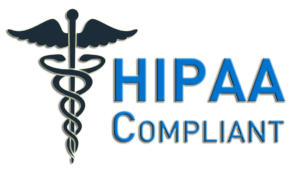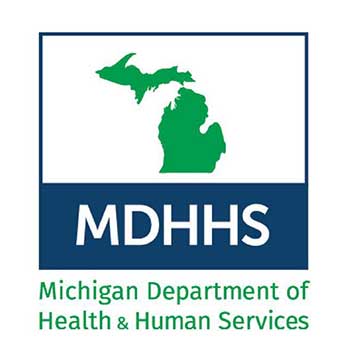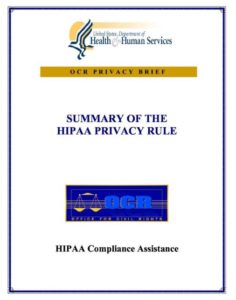HIPAA ~
This is a summary of key elements of the Privacy Rule including who is covered, what information is protected, and how protected health information can be used and disclosed. Because it is an overview of the Privacy Rule, it does not address every detail of each provision.
Prior to HIPPA, there was no uniformity; Statutes varied from state to state, and even from one healthcare organization to another. If an organization was doing business in multiple states, they were subject to the rules of the state where each office was located, or by the rules of the state where the headquarters was located? Should they follow state rules and regulations, or federal guidelines? HIPAA Law provides a uniform, basic level of security and privacy throughout the country.
Some of the HIPPA laws are easy to understand but, many of the regulations are subjective and specific to certain cases. Basically, a healthcare provider needs to examine the requirements, take a look at the current way things are being handled, particularly the personal health information, and apply the regulations in a way that makes the most sense. But keep in mind in areas where existing state law is stricter, those local statutes take precedence over any similar HIPAA laws.
The Standards for Privacy of Individually Identifiable Health Information (“Privacy Rule”) establishes, for the first time, a set of national standards for the protection of certain health information. The U.S. Department of Health and Human Services (“HHS”) issued the Privacy Rule to implement the requirement of the Health Insurance Portability and Accountability Act of 1996 (“HIPAA”).1 The Privacy Rule standards address the use and disclosure of individuals’ health information—called “protected health information” by organizations subject to the Privacy Rule — called “covered entities,” as well as standards for individuals' privacy rights to understand and control how their health information . Within HHS, the Office for Civil Rights (“OCR”) has responsibility for implementing and enforcing the Privacy Rule concerning voluntary compliance activities and civil money penalties. A primary goal of the Privacy Rule is to assure that individuals’ health information is properly protected while allowing the flow of health information needed to provide and promote health care and to protect the public's health and well being. The Rule strikes a balance that permits important uses of information while protecting the privacy of people who seek care and hea ling is a summary of key elements of the Privacy Rule and not a complete or comprehensive guide to compliance. Entities regulated by the Rule are obligated to comply with all of its applicable requirements and should not rely on this summary as a source of legal information or advice.
Statutory and Regulatory Background
The Health Insurance Portability and Accountability Act of 1996 (HIPAA), Public Law 104-191, was enacted on August 21, 1996. Sections 261 through 264 of HIPAA require the Secretary of HHS to publicize standards for the electronic exchange, privacy and security of health information. Collectively these are known as the Administrative Simplification provisions.HIPAA required the Secretary to issue privacy regulations governing individually identifiable health information if Congress did not enact privacy legislation within three years of the passage of HIPAA. Because Congress did not enact privacy legislation, HHS developed a proposed rule and released it for public comment on November 3, 1999. The Department received over 52,000 public comments. The final regulation, the Privacy Rule, was published December 28, 2000.2 In March 2002, the Department proposed and released for public comment modifications to the Privacy Rule. The Department received over 11,000 comments. The final modifications were published in final form on August 14, 2002.3 A text combining the final regulation and the modifications can be found at 45 CFR Part 160 and Part 164, Subparts A and E.
Who is Covered by the Privacy Rule
The Privacy Rule, as well as all the Administrative Simplification rules, apply to health plans, health care clearinghouses, and to any health care provider who transmits health information in electronic form in connection with transactions for which the Secretary of HHS has adopted standards under HIPAA (the “covered entities”).
Health Plans. Individual and group plans that provide or pay the cost of medical care are covered entities.4 Health plans include health, dental, vision, and prescription drug insurers, health maintenance organizations (“HMOs”), Medicare, Medicaid, Medicare+Choice and Medicare supplement insurers, and long-term care insurers (excluding nursing home fixed-indemnity policies). Health plans also include employer-sponsored group health plans, government, and church-sponsored health plans, and multi-employer health plans. There are exceptions—a group health plan with less than 50 participants that is administered solely by the employer that established and maintains the plan is not a covered entity. Two types of government-funded programs are not health plans: (1) those whose principal purpose is not providing or paying the cost of health care, such as the food stamps program; and (2) those programs whose principal activity is directly providing health care, such as a community health center,5 or the making of grants to fund the direct provision of health care. Certain types of insurance entities are also not health plans, including entities providing only workers’ compensation, automobile insurance, and property and casualty insurance. If an insurance entity has separable lines of business, one of which is a health plan, the HIPAA regulations apply to the entity with respect to the health plan line of business.
Health Care Providers. Every health care provider, regardless of size, who electronically transmits health information in connection with certain transactions, is a covered entity. These transactions include claims, benefit eligibility inquiries, referral authorization requests, or other transactions for which HHS has established standards under the HIPAA Transactions Rule.6 Using electronic technology, such as email, does not mean a health care provider is a covered entity; the transmission must be in connection with a standard transaction. The Privacy Rule covers a health care provider whether it electronically transmits these transactions directly or uses a billing service or other third party to do so on its behalf. Health care providers include all “providers of services” (e.g., institutional providers such as hospitals) and “providers of medical or health services” (e.g., non-institutional providers such as physicians, dentists and other practitioners) as defined by Medicare, and any other person or organization that furnishes, bills, or is paid for health care.

Michigan Department of Health
& Human Services Information

An Individual's Rights under HIPAA
HIPAA Privacy and the Individual's Power to Exercise Their Rights. Click here for access to privacy right request and complaint forms.
Authorization to Disclose Protected Health Information
Before Department staff can release protected health information to anyone not involved in treatment, payment or health care operations, a completed copy of the MDCH-1183, Authorization to Disclose Protected Health Information, must be on file with the Department.

HIPAA Frequently Asked Questions
Do you have Questions?
Please contact us, our staff can assist you with any further information needed.

